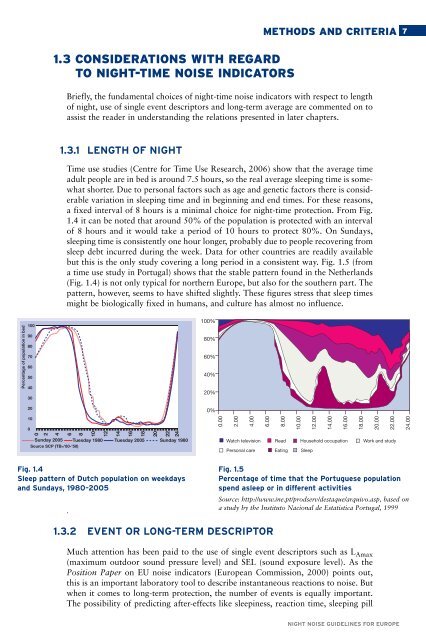Night noise guidelines for Europe - WHO/Europe - World Health ...
Night noise guidelines for Europe - WHO/Europe - World Health ...
Night noise guidelines for Europe - WHO/Europe - World Health ...
You also want an ePaper? Increase the reach of your titles
YUMPU automatically turns print PDFs into web optimized ePapers that Google loves.
1.3 CONSIDERATIONS WITH REGARD<br />
TO NIGHT-TIME NOISE INDICATORS<br />
METHODS AND CRITERIA 7<br />
Briefly, the fundamental choices of night-time <strong>noise</strong> indicators with respect to length<br />
of night, use of single event descriptors and long-term average are commented on to<br />
assist the reader in understanding the relations presented in later chapters.<br />
1.3.1 LENGTH OF NIGHT<br />
Time use studies (Centre <strong>for</strong> Time Use Research, 2006) show that the average time<br />
adult people are in bed is around 7.5 hours, so the real average sleeping time is somewhat<br />
shorter. Due to personal factors such as age and genetic factors there is considerable<br />
variation in sleeping time and in beginning and end times. For these reasons,<br />
a fixed interval of 8 hours is a minimal choice <strong>for</strong> night-time protection. From Fig.<br />
1.4 it can be noted that around 50% of the population is protected with an interval<br />
of 8 hours and it would take a period of 10 hours to protect 80%. On Sundays,<br />
sleeping time is consistently one hour longer, probably due to people recovering from<br />
sleep debt incurred during the week. Data <strong>for</strong> other countries are readily available<br />
but this is the only study covering a long period in a consistent way. Fig. 1.5 (from<br />
a time use study in Portugal) shows that the stable pattern found in the Netherlands<br />
(Fig. 1.4) is not only typical <strong>for</strong> northern <strong>Europe</strong>, but also <strong>for</strong> the southern part. The<br />
pattern, however, seems to have shifted slightly. These figures stress that sleep times<br />
might be biologically fixed in humans, and culture has almost no influence.<br />
P er centage of population in be d<br />
100<br />
90<br />
80<br />
70<br />
60<br />
50<br />
40<br />
30<br />
100%<br />
80%<br />
60%<br />
40%<br />
20%<br />
20<br />
0%<br />
10<br />
0<br />
0.00<br />
2.00<br />
4.00<br />
6.00<br />
8.00<br />
10.00<br />
12.00<br />
14.00<br />
16.00<br />
18.00<br />
20.00<br />
22.00<br />
24.00<br />
0<br />
2<br />
4<br />
6<br />
8<br />
10<br />
12<br />
14<br />
16<br />
18<br />
20<br />
22<br />
24<br />
Sunday 2005 Tuesday 1980 Tuesday 2005 Sunday 1980<br />
Source SCP (TB='80-'50)<br />
Watch television Read Household occupation Work and study<br />
Personal care Eating Sleep<br />
Fig. 1.4<br />
Sleep pattern of Dutch population on weekdays<br />
and Sundays, 1980–2005<br />
.<br />
Fig. 1.5<br />
Percentage of time that the Portuguese population<br />
spend asleep or in different activities<br />
Source: http://www.ine.pt/prodserv/destaque/arquivo.asp, based on<br />
a study by the Instituto Nacional de Estatistica Portugal, 1999<br />
1.3.2 EVENT OR LONG-TERM DESCRIPTOR<br />
Much attention has been paid to the use of single event descriptors such as L Amax<br />
(maximum outdoor sound pressure level) and SEL (sound exposure level). As the<br />
Position Paper on EU <strong>noise</strong> indicators (<strong>Europe</strong>an Commission, 2000) points out,<br />
this is an important laboratory tool to describe instantaneous reactions to <strong>noise</strong>. But<br />
when it comes to long-term protection, the number of events is equally important.<br />
The possibility of predicting after-effects like sleepiness, reaction time, sleeping pill<br />
NIGHT NOISE GUIDELINES FOR EUROPE

















